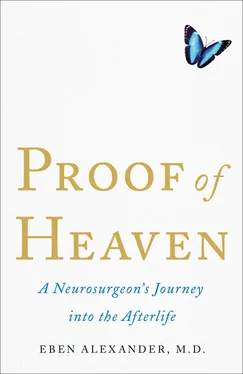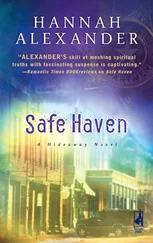The mortality rate for gram-negative meningitis in children and adults ranges from 40 to 80 percent. Dr. Alexander presented to the hospital with seizures and a markedly altered mental status, both of which are risk factors for neurological complications or death (mortality over 90 percent). Despite prompt and aggressive antibiotic treatment for his E.coli meningitis as well as continued care in the medical intensive care unit, he remained in a coma six days and hope for a quick recovery faded (mortality over 97 percent). Then, on the seventh day, the miraculous happened—he opened his eyes, became alert, and was quickly weaned from the ventilator. The fact that he went on to have a full recovery from this illness after being in a coma for nearly a week is truly remarkable.
—Scott Wade, M.D.
APPENDIX B
Neuroscientific Hypotheses I Considered to Explain My Experience
In reviewing my recollections with several other neurosurgeons and scientists, I entertained several hypotheses that might explain my memories. Cutting right to the chase, they all failed to explain the rich, robust, intricate interactivity of the Gateway and Core experiences (the “ultra-reality”). These included:
1. A primitive brainstem program to ease terminal pain and suffering (“evolutionary argument”—possibly as a remnant of “feigned-death” strategies from lower mammals?). This did not explain the robust, richly interactive nature of the recollections.
2. The distorted recall of memories from deeper parts of the limbic system (for example, the lateral amygdala) that have enough overlying brain to be relatively protected from the meningitic inflammation, which occurs mainly at the brain’s surface. This did not explain the robust, richly interactive nature of the recollections.
3. Endogenous glutamate blockade with excitotoxicity, mimicking the hallucinatory anesthetic, ketamine (occasionally used to explain NDEs in general). I occasionally saw the effects of ketamine used as an anesthetic during the earlier part of my neurosurgical career at Harvard Medical School. The hallucinatory state it induced was most chaotic and unpleasant, and bore no resemblance whatsoever to my experience in coma.
4. N,N-dimethyltryptamine (DMT) “dump” (from the pineal, or elsewhere in the brain). DMT, a naturally occurring serotonin agonist (specifically at the 5-HT1A, 5-HT2A and 5-HT2C receptors), causes vivid hallucinations and a dreamlike state. I am personally familiar with drug experiences related to serotonin agonist/antagonists (that is, LSD, mescaline) from my teen years in the early 1970s. I have had no personal experience with DMT but have seen patients under its influence. The rich ultra-reality would still require fairly intact auditory and visual neocortex as target regions in which to generate such a rich audiovisual experience as I had in coma. Prolonged coma due to bacterial meningitis had badly damaged my neocortex, which is where all of that serotonin from the raphe nuclei in the brainstem (or DMT, a serotonin agonist) would have had effects on visual/auditory experience. But my cortex was off, and the DMT would have had no place in the brain to act. The DMT hypothesis failed on the basis of the ultra-reality of the audiovisual experience, and lack of cortex on which to act.
5. Isolated preservation of cortical regions might have explained some of my experience, but were most unlikely, given the severity of my meningitis and its refractoriness to therapy for a week: peripheral white blood cell (WBC) count over 27,000 per mm 3, 31 percent bands with toxic granulations, CSF WBC count over 4,300 per mm 3, CSF glucose down to 1.0 mg/dl, CSF protein 1,340 mg/dl, diffuse meningeal involvement with associated brain abnormalities revealed on my enhanced CT scan, and neurological exams showing severe alterations in cortical function and dysfunction of extraocular motility, indicative of brainstem damage.
6. In an effort to explain the “ultra-reality” of the experience, I examined this hypothesis: Was it possible that networks of inhibitory neurons might have been predominantly affected, allowing for unusually high levels of activity among the excitatory neuronal networks to generate the apparent “ultra-reality” of my experience? One would expect meningitis to preferentially disturb the superficial cortex, possibly leaving deeper layers partially functional. The computing unit of the neocortex is the six-layered “functional column,” each with a lateral diameter of 0.2–0.3 mm. There is significant interwiring laterally to immediately adjacent columns in response to modulatory control signals that originate largely from subcortical regions (the thalamus, basal ganglia, and brainstem). Each functional column has a component at the surface (layers 1–3), so that meningitis effectively disrupts the function of each column just by damaging the surface layers of the cortex. The anatomical distribution of inhibitory and excitatory cells, which have a fairly balanced distribution within the six layers, does not support this hypothesis. Diffuse meningitis over the brain’s surface effectively disables the entire neocortex due to this columnar architecture. Full-thickness destruction is unnecessary for total functional disruption. Given the prolonged course of my poor neurological function (seven days) and the severity of my infection, it is unlikely that even deeper layers of the cortex were still functioning.
7. The thalamus, basal ganglia, and brainstem are deeper brain structures (“subcortical regions”) that some colleagues postulated might have contributed to the processing of such hyperreal experiences. In fact, none of those structures could play any such role without having at least some regions of the neocortex still intact. All agreed in the end that such subcortical structures alone could not have handled the intense neural calculations required for such a richly interactive experiential tapestry.
8. A “reboot phenomenon”—a random dump of bizarre disjointed memories due to old memories in the damaged neocortex, which might occur on restarting the cortex into consciousness after a prolonged system-wide failure, as in my diffuse meningitis. Especially given the intricacies of my elaborate recollections, this seems most unlikely.
9. Unusual memory generation through an archaic visual pathway through the midbrain, prominently used in birds but only rarely identifiable in humans. It can be demonstrated in humans who are cortically blind, due to damaged occipital cortex. It provided no clue as to the ultra-reality I witnessed, and failed to explain the auditory-visual interleaving.
About the Author & Copyright
EBEN ALEXANDER, M.D.,has been an academic neurosurgeon for the last 25 years, including 15 years at the Brigham & Women’s and the Children’s Hospitals and Harvard Medical School in Boston.
Visit him at www.lifebeyonddeath.net.
MEET THE AUTHORS, WATCH VIDEOS AND MORE AT
SimonandSchuster.com
JACKET DESIGN BY CHRISTOPHER LIN
BUT TERFLY PHOTOGRAPH BY OLIVER BURSTON/IKON IMAGES/GETTY IMAGES
AUTHOR PHOTOGRAPH BY DEBORAH FEINGOLD
COPYRIGHT © 2012 SIMON & SCHUSTER
Atwater, F. Holmes. Captain of My Ship, Master of My Soul. Charlottesville, VA: Hampton Roads, 2001.
Atwater, P. M. H. Near-Death Experiences: The Rest of the Story. Charlottesville, VA: Hampton Roads, 2011.
Bache, Christopher. Dark Night, Early Dawn: Steps to a Deeper Ecology of Mind . Albany, NY: State University of New York Press, 2000.
Buhlman, William. The Secret of the Soul: Using Out-of-Body Experiences to Understand Our True Nature. New York: HarperCollins, 2001.
Читать дальше












